You have no items in your shopping cart.
Performance Ignition Basics
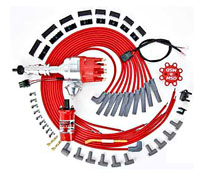 Providing enough spark at the right time to your engine is what building the right ignition system is all about. How much spark you need and timing are all dependent on whether you race or drive a street car. Ignition systems basically take a low voltage charge from your car battery (usually 12 volts), boosts the voltage on the charge and distributes the boosted charge on the compression stroke to each engine cylinder as each piston nears top dead center. Timing controls, or simply adjusting timing, are methods used to control when the spark goes off in relation to the piston position. Igniting the mix thoroughly leads to efficient fuel mileage and also maximizes power potential. Distributors, computer controlled ignition, magnetos and crank triggers distribute the electricity to each cylinder through spark plug wires. Ignition system accessories such as ignition control boxes help manage timing and set RPM limitations. All of these products make up a performance ignition system.
Providing enough spark at the right time to your engine is what building the right ignition system is all about. How much spark you need and timing are all dependent on whether you race or drive a street car. Ignition systems basically take a low voltage charge from your car battery (usually 12 volts), boosts the voltage on the charge and distributes the boosted charge on the compression stroke to each engine cylinder as each piston nears top dead center. Timing controls, or simply adjusting timing, are methods used to control when the spark goes off in relation to the piston position. Igniting the mix thoroughly leads to efficient fuel mileage and also maximizes power potential. Distributors, computer controlled ignition, magnetos and crank triggers distribute the electricity to each cylinder through spark plug wires. Ignition system accessories such as ignition control boxes help manage timing and set RPM limitations. All of these products make up a performance ignition system.
High performance ignition products are available to enhance stock systems, or to make full-on race ignition systems. It's important to choose ignition products for your application. For example: You typically would not run a drag racing coil on a street car because the coil would burn up. Drag racing coils are made for high energy one time passes down the strip.
Performance Ignition Coils
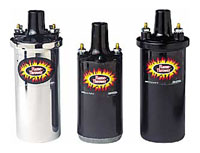 Ignition coils take the voltage from your battery and boost it to a much higher voltage. Depending on the coil, this can be 20,000 or 60,000 volts and beyond. High performance coils are made for certain applications. Because of the heat factor, consideration must be made for the type of driving you will be doing. Coils for drag racing can heat up tremendously. This is fine for short runs down the track. Circle track racing would require a different coil that can withstand prolonged heat.
Ignition coils take the voltage from your battery and boost it to a much higher voltage. Depending on the coil, this can be 20,000 or 60,000 volts and beyond. High performance coils are made for certain applications. Because of the heat factor, consideration must be made for the type of driving you will be doing. Coils for drag racing can heat up tremendously. This is fine for short runs down the track. Circle track racing would require a different coil that can withstand prolonged heat.
There are several types of ignition coils. Most people are familiar with the barrel coil (cylinder shaped coil). It has a place for a coil to distributor wire and a positive terminal to provide power, usually through an ignition switch. The negative terminal on the coil goes to the distributor. Another type of coil is used in HEI type ignition systems. It generally fits under the HEI distributor cap and doesn't require the coil to plug wire that a barrel coil would use. Newer engines are utilizing a coil on plug system where each spark plug wire has a coil where the wire pushes onto the spark plug. Low voltage is distributed from the computer and the voltage boosted right before the spark plug.
How much spark you need is dependent on a few things. Big cube engines that burn a large volume of fuel and air require more spark, or voltage, to insure thorough combustion. Engines with smaller combustion chambers can generally use less spark. Matching the right size coil to your engine and application is the trick.
Distributors, Electronic and Crank Trigger Ignition Systems
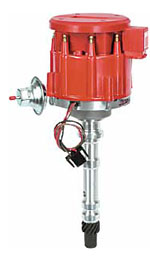 There are several ways that different engines use to get the spark to each cylinder on time. Distributors use a gear on the cam to turn the distributor shaft. At the top of the distributor are points, or another type of trigger/module system, that sends the electric up through the rotor where it makes contact with a contact point on the distributor cap. Each contact point on a distributor cap corresponds to a cylinder. If the rotor points to the contact point on the cap for cylinder number 3, cylinder number 3 gets the spark. Originally points type systems were used. They require routine maintenance to keep the gap, but are simple and function well. Electronic systems have generally replaced points type distributor. There are also modules to upgrade older points type distributors.
There are several ways that different engines use to get the spark to each cylinder on time. Distributors use a gear on the cam to turn the distributor shaft. At the top of the distributor are points, or another type of trigger/module system, that sends the electric up through the rotor where it makes contact with a contact point on the distributor cap. Each contact point on a distributor cap corresponds to a cylinder. If the rotor points to the contact point on the cap for cylinder number 3, cylinder number 3 gets the spark. Originally points type systems were used. They require routine maintenance to keep the gap, but are simple and function well. Electronic systems have generally replaced points type distributor. There are also modules to upgrade older points type distributors.
Crank triggers are generally for high horsepower and racing applications. Crank triggers are extremely accurate at delivering spark on time. As you might expect, a crank trigger system utilizes a wheel that attaches to the crankshaft. As the crank turns, the crank trigger wheel stud passes a non-magnetic pickup where the spark is triggered. Timing the spark to the piston position is critical. Because the crank and pistons are directly linked, a crank trigger is very accurate at delivering spark. Distributors on the other hand are less accurate because of the number of mechanical connections that are in between the crankshaft and the distributor. First the cam is connected to the crank most often with a timing chain. There can be a small amount of stretch that occurs at this point. The distributor gear and cam gear can have a small amount of play in them. As an engine wears, the amount of play only gets worse. Add those mechanical connections up and you can see that the crank trigger is more accurate.
Spark Plug Wires
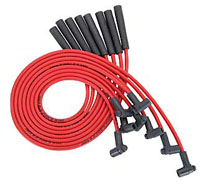 Spark plug wires deliver high voltage electricity to each spark plug. There are some important things to consider when buying spark plug wires. Spark plug wires have to function near exhaust manifolds and headers. Spark plug boots need to be able to withstand that heat. However, it's up to you to make sure you route wires away from heat sources as much as you can. Low resistance wires are best as they are more efficient at delivering spark to each plug. When high voltage runs through a wire, you naturally get electromagnetic interference (or EMI for short). EMI can be a problem with other electronic devices. It's often heard in stereo systems as a hum, but can also be a problem with rev limiters. One last, often overlooked part of the spark plug wire is the crimped on end. A good crimp is key to making a wire that delivers the peak amount of coil energy.
Spark plug wires deliver high voltage electricity to each spark plug. There are some important things to consider when buying spark plug wires. Spark plug wires have to function near exhaust manifolds and headers. Spark plug boots need to be able to withstand that heat. However, it's up to you to make sure you route wires away from heat sources as much as you can. Low resistance wires are best as they are more efficient at delivering spark to each plug. When high voltage runs through a wire, you naturally get electromagnetic interference (or EMI for short). EMI can be a problem with other electronic devices. It's often heard in stereo systems as a hum, but can also be a problem with rev limiters. One last, often overlooked part of the spark plug wire is the crimped on end. A good crimp is key to making a wire that delivers the peak amount of coil energy.
High Performance CD Ignition Boxes
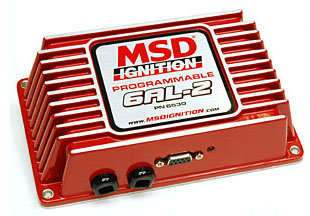 There is small amount of time that elapses when a coil converts the low voltage from the battery to the high voltage needed for spark. This is called dwell. At low RPM's, this usually is not a concern. Most coils have time to convert the electric to high voltage before the next spark. When you speed up RPM, your engine requires spark faster.
There is small amount of time that elapses when a coil converts the low voltage from the battery to the high voltage needed for spark. This is called dwell. At low RPM's, this usually is not a concern. Most coils have time to convert the electric to high voltage before the next spark. When you speed up RPM, your engine requires spark faster.
Think of it like this:
Low RPM = spark.........spark........spark........spark
High RPM would be more like this: spark..spark..spark..spark
You will generally still get a spark at high RPM, but the voltage may not have totally built up in the coil before that energy is needed to fire a cylinder. One way to help this situation is to use a CD ignition box or capacitive discharge box. CD boxes use a capacitor to store up electricity at a higher voltage than your battery to feed the coil. A typical ignition box stores energy at around 500 volts. Since the power is already boosted to a higher voltage before it gets to the coil, the coil recovery time is reduced. That is to say: One burst of high voltage electric leaves the coil and the next burst builds faster than if you had only 12 volts coming in.
While the CD ignition box fixed one problem, it developed another. Spark duration is another aspect of good combustion. Spark duration is how long the spark from the plug lasts compared to crankshaft rotation. If the spark duration is too short, the air/fuel mixture won't completely burn, wasting fuel and sacrificing horsepower. CD ignition boxes do a great job at helping the coil provide enough power to the spark plugs, but may not provide a spark that lasts long enough for total combustion. Multi-Spark ignition boxes are now the norm to combat the spark duration issue. While an ignition coil normally sends one burst of energy to each cylinder for a certain duration of time, the Multi-Spark CD ignition box can deliver multiple bursts of energy to last that same duration. At low and mid RPMs, CD Ignition Boxes deliver multiple sparks that improves idle quality and helps to complete fuel burning. The number of sparks at higher RPM's remains singular. A high revving engine will not allow enough time to regenerate the power to make multiple sparks at high RPM.
Timing Controls
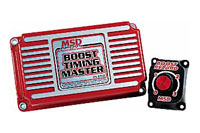 Often in boosted or high compression vehicles, the pressure of the piston compressing the air/fuel mixture will cause detonation (knock) when the spark is generated. To avoid this issue, or simply to control engine timing, electronic timing controls are available. Timing controllers let you delay the spark timing. Because the spark happens at the end of the compression cycle, an early spark would cause the air/fuel mixture to burn early. This would add force to push the piston away from the head, when the piston is still moving toward the head, or compressing. Timing controls can help prevent this by delaying the spark to allow the piston to complete its compression cycle before sparking.
Often in boosted or high compression vehicles, the pressure of the piston compressing the air/fuel mixture will cause detonation (knock) when the spark is generated. To avoid this issue, or simply to control engine timing, electronic timing controls are available. Timing controllers let you delay the spark timing. Because the spark happens at the end of the compression cycle, an early spark would cause the air/fuel mixture to burn early. This would add force to push the piston away from the head, when the piston is still moving toward the head, or compressing. Timing controls can help prevent this by delaying the spark to allow the piston to complete its compression cycle before sparking.
It's important to know that detonation/knock can't always be fixed with an ignition timing control. There can be internal engine components causing detonation. Heat is ultimately the reason for knock. Hot spots in the combustion chamber can be a cause. Relief cuts in pistons sometimes heat up to a higher temperature because the metal may be thinner in a relief cut. Lowering the engine temperature is almost always a good idea. There are many ways to reduce combustion and cylinder head temperature. Cold air kits allow cooler air to enter the engine. A cooler intake charge will produce more horsepower and may help reduce knock. Be sure to route fuel lines away from heat sources where they could pickup heat. Header wrap may help by evacuating more hot exhaust away from the engine.

